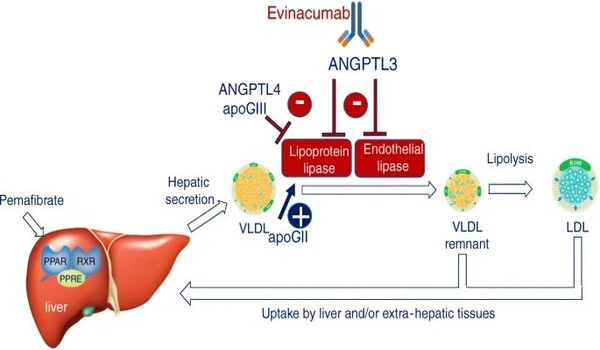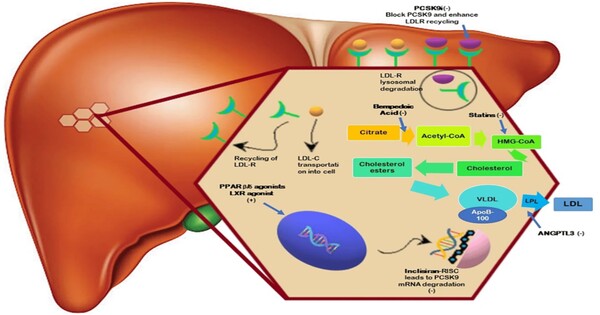Scientists at Nagoya University in Japan have discovered an important advance in the treatment of lipid diseases. Researchers created ZTA-261, a novel chemical that specifically binds to the thyroid hormone receptor beta. THRβ regulates lipid metabolism, affecting blood levels. Mice treated with the medicine had lower cholesterol levels in the liver and blood, as well as less negative effects in the liver, heart, and bones than previous compounds. These findings, reported in Communications Medicine, indicate that ZTA-261 is a viable treatment for lipid diseases such as dyslipidemia.
Approximately one out of every ten people is classed as fat or overweight, which is frequently caused by faulty lipid metabolism. Dyslipidemia, or abnormal blood lipid levels, increases the risk of chest discomfort, heart attack, and stroke.
There is a rising interest in creating dyslipidemia treatments based on thyroid hormone characteristics. Thyroid hormones stimulate metabolism by attaching to two receptors: alpha (THRα) and beta (THRβ). The brain, heart, and muscle have the α-subtype, while the liver and pituitary gland largely express the β-subtype.
Our findings suggest that ZTA-261 is much less toxic than T3 and even less toxic than GC-1, which is known as a THRβ-selective compound. I find it amazing that the difference in THR beta-selectivity between ZTA-261 and GC-1 – 100 times selectivity vs. 20 times selectivity – truly has this big an impact on heart and bone toxicity.
Taeko Ohkawa
Treatments that rely on THR activation face challenges due to the side effects of thyroid hormones. Although THRα regulates cardiovascular functions, excess levels of thyroid hormone lead to adverse effects in nearby organs such as heart enlargement and muscle and bone wasting. On the other hand, activation of THRβ influences lipid metabolism without these severe side effects.
As a result, THRβ has become a desirable target for treating metabolic disorders such as dyslipidemia. However, common treatments, such as the natural thyroid hormone T3, show almost no selectivity between the α and β receptors, making it difficult to avoid the severe side effects caused by binding to THRα.
To address this problem, a research team, including Masakazu Nambo, Taeko Ohkawa, Ayato Sato, Cathleen Crudden, and Takashi Yoshimura from Nagoya University’s WPI-ITbM, developed ZTA-261, a thyroid hormone derivative drug with a similar structure. To test its efficacy, they compared it with GC-1, another thyroid hormone derivative, and the natural thyroid hormone T3 in a mouse model.

They found that ZTA-261 had almost 100 times higher selectivity for THRβ than THRα. In comparison, GC-1 showed only a 20-fold difference in affinity, showing ZTA-261’s superior selectivity. This was confirmed by the significant increase in heart weight and bone damage indicators in T3-treated mice but not in those treated with ZTA-261.
“Our findings suggest that ZTA-261 is much less toxic than T3 and even less toxic than GC-1, which is known as a THRβ-selective compound,” Ohkawa said. “I find it amazing that the difference in THR beta-selectivity between ZTA-261 and GC-1 — 100 times selectivity vs. 20 times selectivity — truly has this big an impact on heart and bone toxicity.”
Many medications have been terminated in preclinical studies due to liver toxicity, thus the researchers tested for potential liver toxicity by assessing alanine aminotransferase (ALT) levels in the blood. Their findings supported the drug’s safety, revealing no significant variations in ALT levels between mice given with ZTA-261 and those treated with saline. Although these findings are intriguing, more research, including human trials, is required before evaluating ZTA-261 for therapeutic application. However, this discovery marks a huge step forward in the development of safer medicines for lipid diseases.
“ZTA-261 has extremely high affinity and selectivity for THRβ among the thyroid hormone derivatives developed to date,” Nambo explained. “In the process of synthesizing a variety of derivatives, we have found that precise molecular design is crucial for both selectivity and affinity. We believe that this study will provide new and important insights into drug discovery.”
















